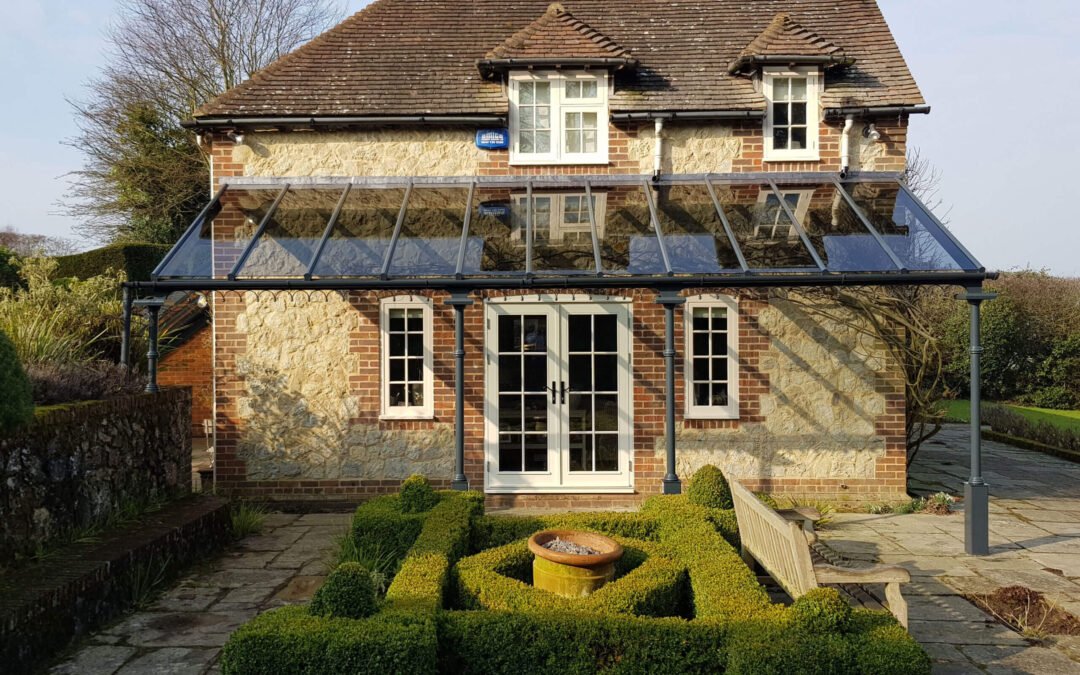Adding a veranda to your home is a fantastic way to create a stylish, sheltered outdoor space you can enjoy all year round. But one of the biggest decisions you’ll need to make early on is what material to choose for your veranda roof: glass or polycarbonate?
Both options have their strengths, and the right choice depends on your home, budget, and how you plan to use the space. In this guide, we’ll break down the pros and cons of each material to help you decide which one best suits your needs.
Aesthetics & Natural Light
One of the main reasons homeowners invest in a veranda is to bring more natural light into their home and garden. In this area, glass and polycarbonate perform quite differently.
Glass roofs provide an ultra-clear, modern look that blends seamlessly with contemporary home designs. The transparency of glass means you can enjoy uninterrupted views of the sky – ideal for those clear summer nights whether you’re entertaining, eating outside or enjoying a quiet drink outside.
Polycarbonate roofs, on the other hand, are available in a variety of finishes including clear, opal, and bronze. While not as visually pristine as glass, they can offer more privacy or reduced glare depending on the tint you choose.
Durability & Longevity
When it comes to strength, both materials hold their own, but in different ways.
Tempered or laminated glass is extremely durable, resistant to scratching, and maintains its clarity for decades. It’s a premium option designed to last, especially when used in double-glazed panels.
Polycarbonate, while less elegant, is highly impact-resistant making it an excellent option. It’s commonly used in greenhouses and industrial settings for a reason. However, over time, cheaper polycarbonate panels may yellow or become brittle if not UV protected resulting in it requiring to be replaced earlier than a glass alternative.
Sound Insulation & Weather Performance
The material you choose will also influence how your veranda performs in the typical British weather.
Glass is significantly better at dampening external noise. Whether it’s heavy rain or strong winds, a glass roof will provide a more peaceful environment underneath. It’s perfect if you plan to use your veranda as an extension of your living or dining space.
Polycarbonate, especially thinner or single-layer sheets, tends to be noisier during rain and hail. While multi-wall versions help reduce this, you may still notice a difference in sound levels.
Thermal Efficiency
If you plan to spend time under your veranda year-round, insulation and thermal control are vital.
Double-glazed glass roofs provide excellent insulation, keeping your space warmer in winter and cooler in summer. They help create a comfortable environment and reduce condensation buildup.
Polycarbonate roofs vary widely depending on their thickness and structure. Multi layer polycarbonate roofs offer better insulation, but single-layer panels may result in extreme temperatures during summer or winter leaving you potential limited on the veranda’s use.
Maintenance and Cleaning
Homeowners often overlook how much effort it takes to keep their veranda roof clean and looking good.
Glass is generally easier to clean. A standard glass cleaner or water and vinegar will usually do the trick, and it resists staining well over time.
Polycarbonate requires more care during cleaning to avoid scratches. It may also attract algae or dirt in textured areas or on older panels. Some types are more susceptible to discolouration with age.
Cost & Installation
Cost is often one of the biggest deciding factors.
Glass verandas are usually more expensive to install. The materials themselves cost more, and due to their weight, they may require stronger support structures. Installation also tends to take longer.
Polycarbonate is much lighter and more affordable. It’s quicker to install and often a more budget-friendly choice, especially for homeowners looking to create an attractive outdoor space without a premium price tag.
|
Feature |
Glass |
Polycarbonate |
|
Appearance |
Clear, elegant, modern look |
Tinted options, functional style |
|
Light |
Maximum clarity and sunlight |
Diffused light, reduces glare |
|
Durability |
Long-lasting, scratch-resistant |
Impact-resistant, may yellow |
|
Noise |
Quieter in rain |
Louder during storms |
|
Insulation |
Excellent with double-glazing |
Varies by type |
|
Maintenance |
Easy to clean |
Requires gentle care |
|
Cost |
Higher upfront cost |
Budget-friendly |
Final Thoughts: Which Is Right for You?
Choosing between glass and polycarbonate veranda roofs comes down to what you value most.
- If you want a sleek, modern look, long-term durability, quiet ambience, and year-round comfort, glass is the superior option.
- If you’re seeking an affordable, lightweight, and impact-resistant solution, polycarbonate might be your perfect fit.
At VerandaLuxe, we offer bespoke veranda solutions in both glass and polycarbonate roofing. Our experts can walk you through your options, based on your home design, goals, and budget.
Ready to start planning your dream veranda?

